Simon Harpin, Head of Policy, BEAMA
14th December 2022
Having identified critical issues with the energy system supply chain, industry is coming together to better understand and resolve ongoing challenges so we can practically deliver for Net Zero.
Lack of Government action, lack of standards, lack of consumer knowledge, lack of money … all commonly complained-about barriers to flexibility and Net Zero. But another fundamental barrier is being encountered with increasing frequency: the state of the supply chain and the availability of products and components. If we can break through all other barriers but can’t get the products in the right places, we can’t deliver. An initial survey by BEAMA has flagged some current issues, and we want to understand more.
From the manufacturer’s perspective, supply chain problems can mean variable contracts, redesigning and retesting of products, and a search for new suppliers.
For the manufacturers’ customers, this can make tenders more difficult to write and could cause delays to projects or changes to emissions calculations.
Of course, all this would likely lead to a worse outcome for the end user.
Having recognised this, a group of organisations has succeeded in taking the somewhat simple but surprisingly unusual step of bringing the supply chain together. This move was instigated by BEAMA and has led to the launch of the Electricity Products Supply Chain Council, which is attended by manufacturers, contractors, distributors, network operators, energy suppliers and standards bodies. We want to work out what’s going on, and what we can do about it.
The scale of the delivery challenge is stark. Modelling carried out by the Energy Systems Catapult and BEAMA shows that critical actions must be completed in the next 5-10 years to avoid increasing the cost of meeting Net Zero (and interim Carbon Budgets) by billions of pounds each year. Unsurprisingly, the Council has also caught the attention of government and regulators, who are keen to know what impact supply chain issues will have on Net Zero and investment policy delivery.
As an example of the scale of investment needed, the modelling suggests an additional 300,000km of distribution cable is needed, with a 10%-30% growth in substation numbers. While to some extent these projected figures can be mitigated by demand-side flexibility, blockages in the various supply chains at play – as diverse as plastics, chips, PPE, and labour – could seriously hinder our ability to deliver the improved energy system (or systems) that we need.
Delivery is the key word for the Council too. We are desperate to avoid becoming just a talking shop, so we have a workplan and key actions already outlined. We will be sharing more news publicly in 2023 but would welcome anyone who has a stake in this area to engage with us and help to inform the Council’s work. We aim to seize the opportunities as well as tackle the challenges.
If you want to know more about the Council or about BEAMA’s work to support the electricity supply chain, please contact Simon.Harpin@beama.org.uk
